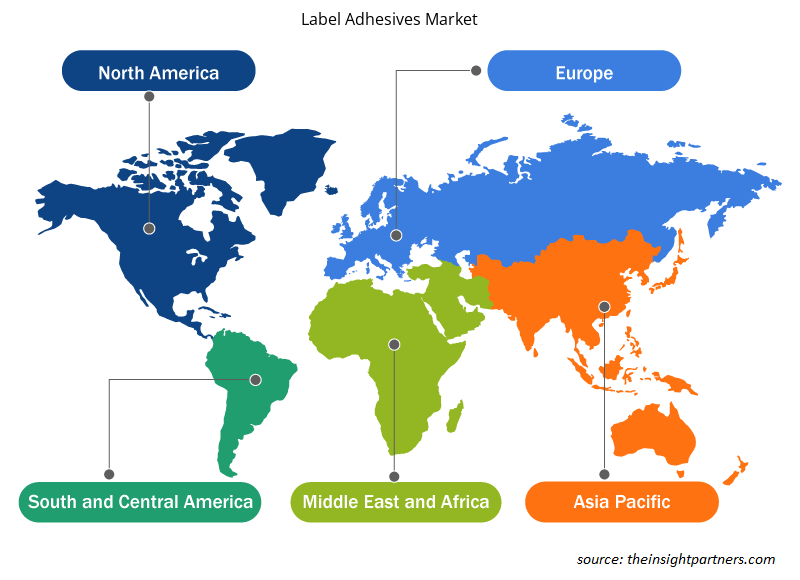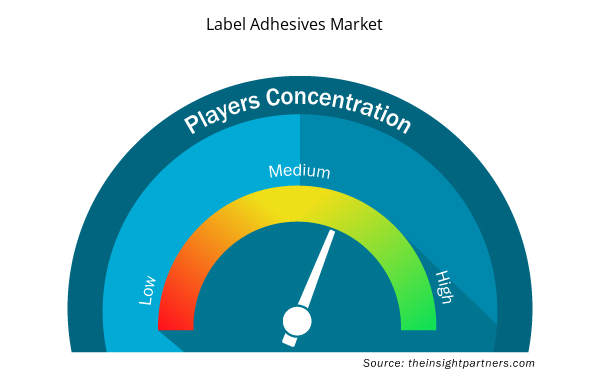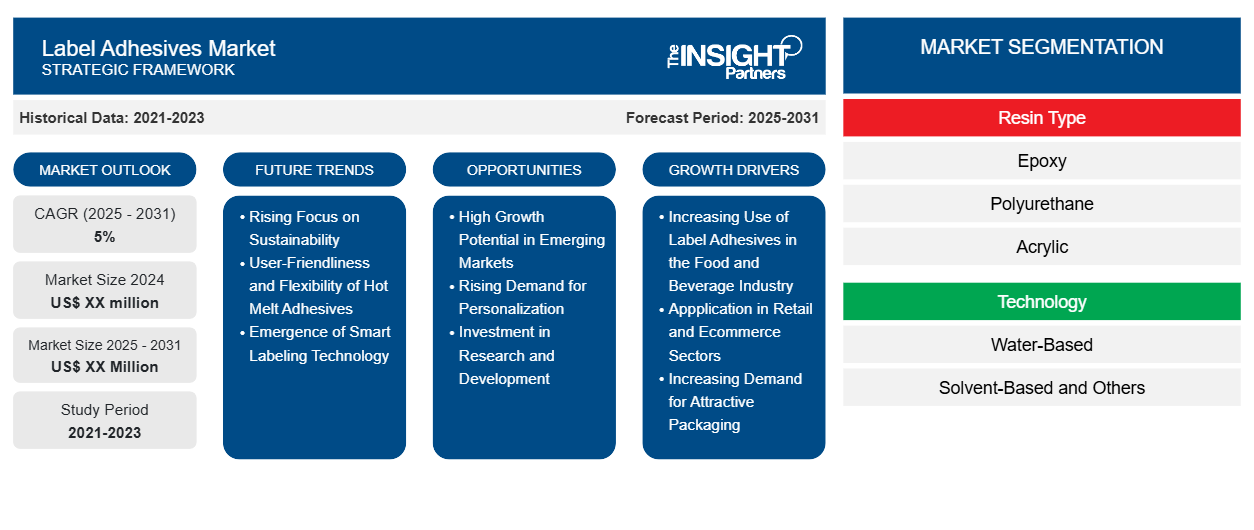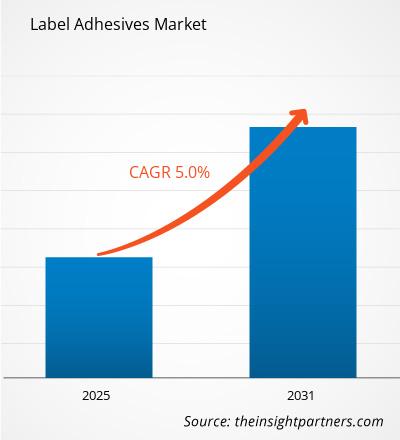Der Markt für Etikettenklebstoffe wird voraussichtlich von 2023 bis 2031 eine durchschnittliche jährliche Wachstumsrate (CAGR) von 5 % verzeichnen, wobei die Marktgröße von XX Millionen US-Dollar im Jahr 2023 auf XX Millionen US-Dollar im Jahr 2031 wachsen wird.
Der Bericht ist nach Harztyp (Epoxid, Polyurethan, Acryl, Polyamid und andere) und Technologie (auf Wasserbasis, auf Lösungsmittelbasis und andere) segmentiert. Der Bericht präsentiert außerdem Analysen basierend auf der Endverbrauchsbranche (Lebensmittel und Getränke, Pharmazeutika, Körperpflege und Kosmetik, Konsumgüter, Haushaltspflegeprodukte und andere). Die globale Analyse ist weiter auf regionaler Ebene und in die wichtigsten Länder unterteilt. Die Marktgröße und -prognose auf globaler, regionaler und Länderebene für alle wichtigen Marktsegmente werden im Rahmen des Berichts abgedeckt. Der Bericht bietet den Wert in USD für die oben genannte Analyse und die Segmente. Der Bericht bietet wichtige Statistiken zum Marktstatus der wichtigsten Marktteilnehmer und bietet Markttrends und -chancen.
Zweck des Berichts
Der Bericht „Label Adhesives Market“ von The Insight Partners soll die aktuelle Situation und das zukünftige Wachstum sowie die wichtigsten treibenden Faktoren, Herausforderungen und Chancen beschreiben. Dies wird verschiedenen Geschäftspartnern Einblicke geben, wie zum Beispiel:
- Technologieanbieter/-hersteller: Um die sich entwickelnde Marktdynamik zu verstehen und die potenziellen Wachstumschancen zu kennen, damit sie fundierte strategische Entscheidungen treffen können.
- Investoren: Durchführung einer umfassenden Trendanalyse hinsichtlich der Marktwachstumsrate, der finanziellen Marktprognosen und der Chancen entlang der Wertschöpfungskette.
- Regulierungsbehörden: Zur Regulierung von Richtlinien und Überwachungsaktivitäten auf dem Markt mit dem Ziel, Missbrauch zu minimieren, das Vertrauen der Anleger zu bewahren und die Integrität und Stabilität des Marktes aufrechtzuerhalten.
Etikettenklebstoffe Marktsegmentierung
Harztyp
- Epoxid
- Polyurethan
- Acryl
- Polyamid und andere
Technologie
- Auf Wasserbasis
- Lösungsmittelbasiert und andere
Endverbrauchsindustrie
- Nahrungsmittel und Getränke
- Pharmazeutika
- Körperpflege und Kosmetik
- Konsumgüter
- Haushaltspflegeprodukte und Sonstiges
Geographie
- Nordamerika
- Europa
- Asien-Pazifik
- Süd- und Mittelamerika
- Naher Osten und Afrika
Geographie
- Nordamerika
- Europa
- Asien-Pazifik
- Süd- und Mittelamerika
- Naher Osten und Afrika
Passen Sie diesen Bericht Ihren Anforderungen an
Sie erhalten kostenlose Anpassungen an jedem Bericht, einschließlich Teilen dieses Berichts oder einer Analyse auf Länderebene, eines Excel-Datenpakets sowie tolle Angebote und Rabatte für Start-ups und Universitäten.
- Holen Sie sich die wichtigsten Markttrends aus diesem Bericht.Dieses KOSTENLOSE Beispiel umfasst eine Datenanalyse von Markttrends bis hin zu Schätzungen und Prognosen.
Wachstumstreiber auf dem Markt für Etikettenklebstoffe
- Zunehmende Verwendung von Etikettenklebstoffen in der Lebensmittel- und Getränkeindustrie: Es gibt einen deutlichen Anstieg der Verwendung von Etikettenklebstoffen im Lebensmittel- und Getränkesektor, der auf den hohen Verbrauch verpackter Lebensmittel und den Bedarf an effizienten Methoden zur Etikettenanbringung zurückzuführen ist. Auch Lebensmittelhersteller sind von den Bedenken hinsichtlich der Lebensmittelkennzeichnung betroffen und die meisten von ihnen suchen nach starken Klebstoffen, die kälte- und feuchtigkeitsbeständig sind und allgemeiner Abnutzung standhalten. Die Vorlieben der Verbraucher bestimmen die Trends auf dem Markt, wobei die meisten Unternehmen für ihre Verpackungsmaterialien lebensmittelechte und umweltverträgliche Klebstoffe verwenden möchten. Dieses wachsende Segment wird die Entwicklung auf dem Markt für Etikettenklebstoffe wahrscheinlich auch weiterhin beeinflussen.
- Anwendung im Einzelhandel und E-Commerce: Der Markt für Etikettenklebstoffe wurde ebenfalls vom Boom des E-Commerce und Einzelhandels beeinflusst. Dies liegt vor allem daran, dass die Menschen mit zunehmendem Online-Shopping immer mehr Schutzverpackungslösungen benötigen, die die Präsenz der Marke verbessern. Es besteht eine steigende Nachfrage nach Klebstoffen zum Anbringen von Etiketten auf Kartons, Behältern und anderen Versandgeräten, um den Lieferservice zu verbessern. Dies ermöglicht es dem Unternehmen, das richtige Produkt effizient an die richtige Adresse zu liefern. Darüber hinaus wird aufgrund des Fokus des Einzelhandelsmarktes auf Branding und visuelle Darstellung der Bedarf an Etikettenklebstoffen von besserer Qualität zwangsläufig steigen.
- Steigende Nachfrage nach attraktiven Verpackungen: Verpackungen, insbesondere attraktive, sind entscheidend für den Umsatz, daher investieren Unternehmen viel Aufwand in das Verpackungsdesign. Klebstoffe für Etiketten mit aufgedruckten Grafiken spielen auch eine wichtige Rolle beim Schutz des Designs und der Farben der Etiketten, was sich auf das Markenimage und die Kundentreue auswirken kann. Der Trend, individuelle und stilvolle Verpackungen anzubieten, setzt sich ebenfalls durch und ermutigt Hersteller, ihre Klebstofftechnologie für kreative Etikettendesigns zu verbessern. Der Bedarf an funktionalen und dennoch attraktiven Etiketten wird steigen, um auf einem immer stärker umkämpften Markt wettbewerbsfähig zu bleiben.
Zukünftige Trends auf dem Markt für Etikettenklebstoffe
- Zunehmender Fokus auf Nachhaltigkeit: Einer der wichtigsten Trends in der Etikettenklebstoffindustrie ist der Übergang zur Nachhaltigkeit. Die Herstellung von Etikettenklebstoffen, beispielsweise aus erneuerbaren Ressourcen und biologisch abbaubaren Rohstoffen, hat für die Hersteller Priorität. Innovationen helfen dabei, Lösungen für die Zielgruppe zu finden, die nach umweltfreundlichen Produkten sucht, und den damit verbundenen Richtlinien Rechnung zu tragen. Daher werden zunehmend wasserbasierte und lösungsmittelfreie Klebstoffe verwendet, um die Emissionen in die Umwelt zu senken und die Nachhaltigkeit der Verpackungslösungen zu fördern.
- Benutzerfreundlichkeit und Flexibilität von Schmelzklebstoffen: Schmelzklebstoffe gewinnen auch auf dem Markt für Etikettenklebstoffe aufgrund ihrer Benutzerfreundlichkeit und Flexibilität stark an Bedeutung. In den neuesten Schmelzklebstofftechnologien wurden neue Formulierungen eingeführt, die ihre Klebeleistung auch unter schwierigen Bedingungen und auf schwierigen Substraten verbessern. Diese Klebstoffe bieten schnelle Aushärtungszeiten und eignen sich daher für Umgebungen mit Hochgeschwindigkeitsproduktion. Technologische Verbesserungen bei Schmelzklebstoffen werden die Etikettierlösungen verbessern und können den Markt zugunsten der Hersteller beeinflussen.
- Aufkommen der Smart-Labeling-Technologie: Das Aufkommen der Smart-Labeling-Technologie eröffnet dem Markt für Etikettenklebstoffe völlig neue Perspektiven. Technologien wie QR-Codes, NFC- und RFID-Tags werden immer häufiger eingesetzt, was eine Nachfrage nach Klebstoffen mit verbesserten Eigenschaften schafft, die in verschiedenen Umgebungen bestimmte Funktionen erfüllen. Solche Lösungen bringen Technologien in die Verpackung von Waren und ermöglichen es den Marken, mit ihren Verbrauchern zu kommunizieren und einige Informationen über das Produkt in elektronischer Form bereitzustellen. Diese Entwicklung ermöglicht es Klebstoffherstellern, eine neue Produktpalette basierend auf den Anforderungen intelligenter Etikettiersysteme zu entwickeln.
Marktchancen für Etikettenklebstoffe
- Hohes Wachstumspotenzial in Schwellenmärkten: In Schwellenmärkten gibt es Potenzial für Hersteller von Etikettierklebstoffen, da die Industrialisierung und die Verbraucherausgaben in diesen Ländern zunehmen. Die Länder im asiatisch-pazifischen Raum, Lateinamerika und Afrika befinden sich alle im Wachstumsmodus, insbesondere im Fertigungs- und Einzelhandelssektor. Daher werden Etikettierlösungen benötigt. Indem sie ihre Produkte an die Angebote und Vorlieben des lokalen Marktes anpassen, können die Unternehmen versuchen, in diese Märkte einzudringen.
- Steigende Nachfrage nach Personalisierung: Die steigende Nachfrage nach personalisierten Etikettierlösungen ist ein neuer Trend auf dem Markt für Etikettenklebstoffe. Immer mehr Unternehmen wünschen sich Etiketten, die sich von den anderen unterscheiden, um ihre Marken noch stärker beim Endverbraucher bekannt zu machen. Hersteller können diesen Trend ausnutzen, indem sie Klebstoffe entwickeln, die anspruchsvolle Drucke ermöglichen, die unterschiedliche Materialien und sehr aufwändige Designs umfassen können. Die Entwicklung von Klebstoffprodukten, die Modifikationen ermöglichen, kann eine Strategie sein, die Unternehmen anwenden können, um bestimmte Kundenbedürfnisse zu erfüllen.
- Investitionen in Forschung und Entwicklung: Forschungs- und Entwicklungsaktivitäten auf dem Markt für Etikettenklebstoffe sollten unterstützt werden, um fortschreitende Veränderungen zu fördern. Unternehmen können nach neuen Rezepturen, neuen Materialarten und neuen leistungsfähigen und umweltfreundlichen Klebetechnologien suchen. Eine F&E, die auf die Entwicklung von Klebstoffen mit höherer Klebkraft, besserer Wärmebeständigkeit und Kompatibilität mit verschiedenen Substraten abzielt, wird den Herstellern helfen, die Spitzenpositionen auf dem Markt einzunehmen. Die Zusammenarbeit mit externen Forschungsorganisationen zur Verkürzung der Markteinführungszeit für Innovationen und neue Produkte kann ebenfalls von Vorteil sein.
Regionale Einblicke in den Markt für Etikettenklebstoffe
Die regionalen Trends und Faktoren, die den Markt für Etikettenklebstoffe im Prognosezeitraum beeinflussen, wurden von den Analysten von Insight Partners ausführlich erläutert. In diesem Abschnitt werden auch die Marktsegmente und die Geografie für Etikettenklebstoffe in Nordamerika, Europa, im asiatisch-pazifischen Raum, im Nahen Osten und Afrika sowie in Süd- und Mittelamerika erörtert.

- Erhalten Sie regionale Daten zum Etikettenklebstoffmarkt
Umfang des Marktberichts zu Etikettenklebstoffen
| Berichtsattribut | Details |
|---|---|
| Marktgröße im Jahr 2023 | XX Millionen US-Dollar |
| Marktgröße bis 2031 | XX Millionen US-Dollar |
| Globale CAGR (2023 - 2031) | 5 % |
| Historische Daten | 2021-2022 |
| Prognosezeitraum | 2024–2031 |
| Abgedeckte Segmente | Nach Harztyp
|
| Abgedeckte Regionen und Länder | Nordamerika
|
| Marktführer und wichtige Unternehmensprofile |
|
Dichte der Marktteilnehmer für Etikettenklebstoffe: Auswirkungen auf die Geschäftsdynamik verstehen
Der Markt für Etikettenklebstoffe wächst rasant, angetrieben durch die steigende Nachfrage der Endverbraucher aufgrund von Faktoren wie sich entwickelnden Verbraucherpräferenzen, technologischen Fortschritten und einem größeren Bewusstsein für die Vorteile des Produkts. Mit steigender Nachfrage erweitern Unternehmen ihr Angebot, entwickeln Innovationen, um die Bedürfnisse der Verbraucher zu erfüllen, und nutzen neue Trends, was das Marktwachstum weiter ankurbelt.
Die Marktteilnehmerdichte bezieht sich auf die Verteilung der Firmen oder Unternehmen, die in einem bestimmten Markt oder einer bestimmten Branche tätig sind. Sie gibt an, wie viele Wettbewerber (Marktteilnehmer) in einem bestimmten Marktraum im Verhältnis zu seiner Größe oder seinem gesamten Marktwert präsent sind.
Die wichtigsten auf dem Markt für Etikettenklebstoffe tätigen Unternehmen sind:
- Ashland Global Holdings Inc.
- Avery Denision
- BOSTIK SA
- DOW Chemical Company
- Etiquette Labels Ltd.
Haftungsausschluss : Die oben aufgeführten Unternehmen sind nicht in einer bestimmten Reihenfolge aufgeführt.

- Überblick über die wichtigsten Akteure auf dem Markt für Etikettenklebstoffe
Wichtige Verkaufsargumente
- Umfassende Abdeckung: Der Bericht deckt die Analyse der Produkte, Dienste, Typen und Endbenutzer des Etikettenklebstoffe-Marktes umfassend ab und bietet einen ganzheitlichen Überblick.
- Expertenanalyse: Der Bericht basiert auf dem umfassenden Verständnis von Branchenexperten und Analysten.
- Aktuelle Informationen: Der Bericht stellt durch die Abdeckung aktueller Informationen und Datentrends Geschäftsrelevanz sicher.
- Anpassungsoptionen: Dieser Bericht kann angepasst werden, um spezifische Kundenanforderungen zu erfüllen und die Geschäftsstrategien optimal anzupassen.
Der Forschungsbericht zum Markt für Etikettenklebstoffe kann daher dabei helfen, die Branchensituation und Wachstumsaussichten zu entschlüsseln und zu verstehen. Obwohl es einige berechtigte Bedenken geben kann, überwiegen die allgemeinen Vorteile dieses Berichts tendenziell die Nachteile.
- Historische Analyse (2 Jahre), Basisjahr, Prognose (7 Jahre) mit CAGR
- PEST- und SWOT-Analyse
- Marktgröße Wert/Volumen – Global, Regional, Land
- Branche und Wettbewerbsumfeld
- Excel-Datensatz



Report Coverage
Revenue forecast, Company Analysis, Industry landscape, Growth factors, and Trends

Segment Covered
This text is related
to segments covered.

Regional Scope
North America, Europe, Asia Pacific, Middle East & Africa, South & Central America

Country Scope
This text is related
to country scope.
Häufig gestellte Fragen
Based on geography, North America held the significant share of the label adhesives market due to growth in the food and beverage and pharmaceuticals sector
Growing demand of eco-friendly adhesives is expected to be the key market trends
Based on end-use industry, consumer goods segment is expected to witness the fastest growth during the forecast period
The Label Adhesives Market is estimated to witness a CAGR of 5% from 2023 to 2031
Growing demand in the food and beverage sector is driving the market growth
Avery Dennison Corporation; Bostik; Dow; H.B. Fuller Company; HERMA GmbH are some of the key players operating in the label adhesives market
Trends and growth analysis reports related to Chemicals and Materials : READ MORE..
The List of Companies
- Ashland Global Holdings Inc.
- Avery Denision
- BOSTIK S.A
- DOW Chemical Company
- Etiquette Labels Ltd.
- H.B. Fuller
- Herma
- Intelligent Label Solutions
- Lintec Corporation
- Pacific Adhesives
The Insight Partners performs research in 4 major stages: Data Collection & Secondary Research, Primary Research, Data Analysis and Data Triangulation & Final Review.
- Data Collection and Secondary Research:
As a market research and consulting firm operating from a decade, we have published and advised several client across the globe. First step for any study will start with an assessment of currently available data and insights from existing reports. Further, historical and current market information is collected from Investor Presentations, Annual Reports, SEC Filings, etc., and other information related to company’s performance and market positioning are gathered from Paid Databases (Factiva, Hoovers, and Reuters) and various other publications available in public domain.
Several associations trade associates, technical forums, institutes, societies and organization are accessed to gain technical as well as market related insights through their publications such as research papers, blogs and press releases related to the studies are referred to get cues about the market. Further, white papers, journals, magazines, and other news articles published in last 3 years are scrutinized and analyzed to understand the current market trends.
- Primary Research:
The primarily interview analysis comprise of data obtained from industry participants interview and answers to survey questions gathered by in-house primary team.
For primary research, interviews are conducted with industry experts/CEOs/Marketing Managers/VPs/Subject Matter Experts from both demand and supply side to get a 360-degree view of the market. The primary team conducts several interviews based on the complexity of the markets to understand the various market trends and dynamics which makes research more credible and precise.
A typical research interview fulfils the following functions:
- Provides first-hand information on the market size, market trends, growth trends, competitive landscape, and outlook
- Validates and strengthens in-house secondary research findings
- Develops the analysis team’s expertise and market understanding
Primary research involves email interactions and telephone interviews for each market, category, segment, and sub-segment across geographies. The participants who typically take part in such a process include, but are not limited to:
- Industry participants: VPs, business development managers, market intelligence managers and national sales managers
- Outside experts: Valuation experts, research analysts and key opinion leaders specializing in the electronics and semiconductor industry.
Below is the breakup of our primary respondents by company, designation, and region:

Once we receive the confirmation from primary research sources or primary respondents, we finalize the base year market estimation and forecast the data as per the macroeconomic and microeconomic factors assessed during data collection.
- Data Analysis:
Once data is validated through both secondary as well as primary respondents, we finalize the market estimations by hypothesis formulation and factor analysis at regional and country level.
- Macro-Economic Factor Analysis:
We analyse macroeconomic indicators such the gross domestic product (GDP), increase in the demand for goods and services across industries, technological advancement, regional economic growth, governmental policies, the influence of COVID-19, PEST analysis, and other aspects. This analysis aids in setting benchmarks for various nations/regions and approximating market splits. Additionally, the general trend of the aforementioned components aid in determining the market's development possibilities.
- Country Level Data:
Various factors that are especially aligned to the country are taken into account to determine the market size for a certain area and country, including the presence of vendors, such as headquarters and offices, the country's GDP, demand patterns, and industry growth. To comprehend the market dynamics for the nation, a number of growth variables, inhibitors, application areas, and current market trends are researched. The aforementioned elements aid in determining the country's overall market's growth potential.
- Company Profile:
The “Table of Contents” is formulated by listing and analyzing more than 25 - 30 companies operating in the market ecosystem across geographies. However, we profile only 10 companies as a standard practice in our syndicate reports. These 10 companies comprise leading, emerging, and regional players. Nonetheless, our analysis is not restricted to the 10 listed companies, we also analyze other companies present in the market to develop a holistic view and understand the prevailing trends. The “Company Profiles” section in the report covers key facts, business description, products & services, financial information, SWOT analysis, and key developments. The financial information presented is extracted from the annual reports and official documents of the publicly listed companies. Upon collecting the information for the sections of respective companies, we verify them via various primary sources and then compile the data in respective company profiles. The company level information helps us in deriving the base number as well as in forecasting the market size.
- Developing Base Number:
Aggregation of sales statistics (2020-2022) and macro-economic factor, and other secondary and primary research insights are utilized to arrive at base number and related market shares for 2022. The data gaps are identified in this step and relevant market data is analyzed, collected from paid primary interviews or databases. On finalizing the base year market size, forecasts are developed on the basis of macro-economic, industry and market growth factors and company level analysis.
- Data Triangulation and Final Review:
The market findings and base year market size calculations are validated from supply as well as demand side. Demand side validations are based on macro-economic factor analysis and benchmarks for respective regions and countries. In case of supply side validations, revenues of major companies are estimated (in case not available) based on industry benchmark, approximate number of employees, product portfolio, and primary interviews revenues are gathered. Further revenue from target product/service segment is assessed to avoid overshooting of market statistics. In case of heavy deviations between supply and demand side values, all thes steps are repeated to achieve synchronization.
We follow an iterative model, wherein we share our research findings with Subject Matter Experts (SME’s) and Key Opinion Leaders (KOLs) until consensus view of the market is not formulated – this model negates any drastic deviation in the opinions of experts. Only validated and universally acceptable research findings are quoted in our reports.
We have important check points that we use to validate our research findings – which we call – data triangulation, where we validate the information, we generate from secondary sources with primary interviews and then we re-validate with our internal data bases and Subject matter experts. This comprehensive model enables us to deliver high quality, reliable data in shortest possible time.


 Holen Sie sich ein kostenloses Muster für diesen Bericht
Holen Sie sich ein kostenloses Muster für diesen Bericht